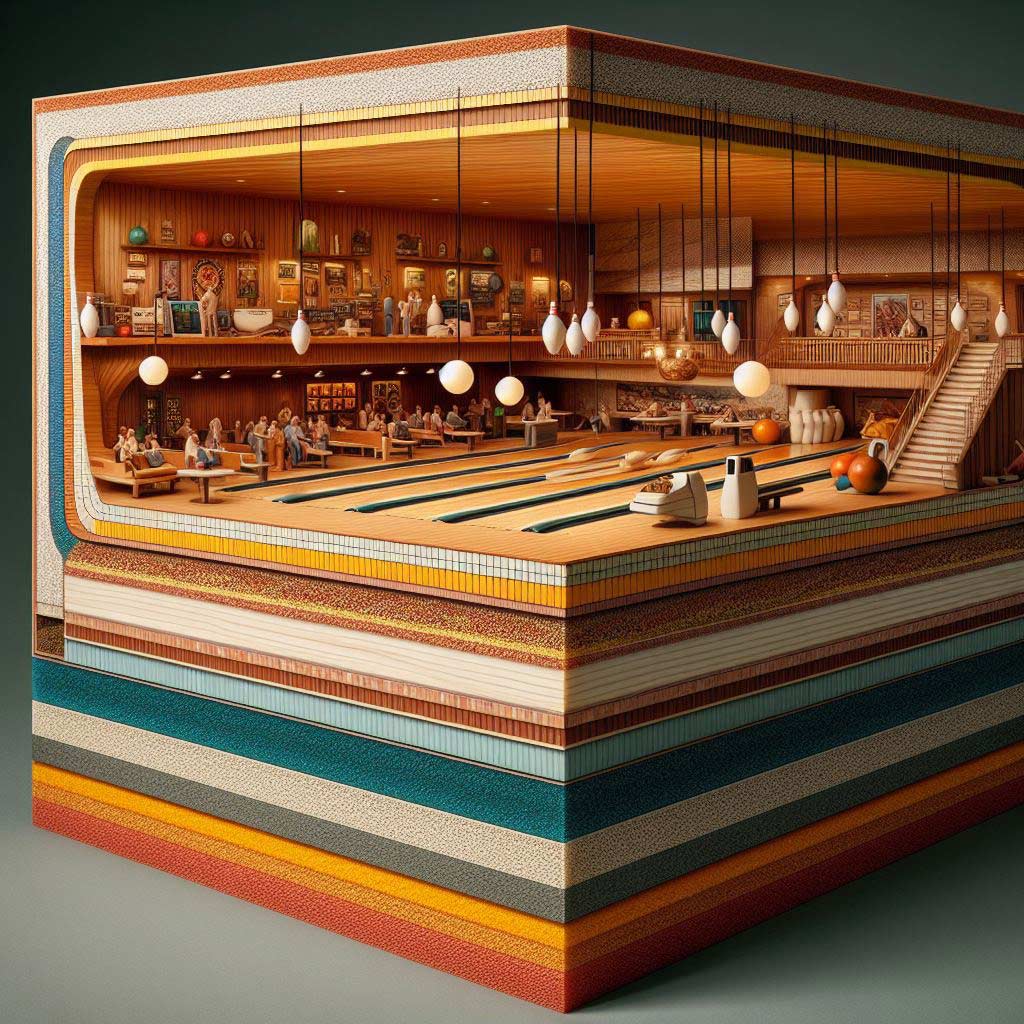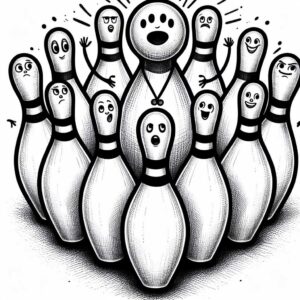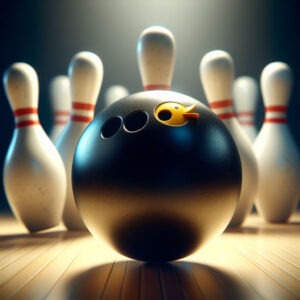Bowling remains one of America’s most popular pastime activities and sports. As technology advances, we are moving past the era of traditional wood lane construction into modern synthetic bowling lanes. In fact, it’s estimated over 90% of new bowling centers being built today utilize synthetic lanes.
But what exactly are these lanes made of? Understanding the composition and properties of the materials that make up bowling lanes allows bowlers to optimize their play.
This article provides a comprehensive breakdown of the typical base materials, finish layers, oils, and additional elements used to construct the modern synthetic bowling lane.
Synthetic Lane Base Materials
The solid base underneath the fine finish layer is the foundation of a quality bowling lane. Traditional wood lanes require continual maintenance and upkeep to maintain consistency and performance. Modern synthetic lanes provide improved durability, longevity, and trueness.
Polyurethane is now the most common base layer for newly constructed bowling lanes. The polyurethane panels are cost-effective, provide stability against moisture damage, and resist impact better than other alternatives. The material consists of resin blended with reinforcing agents that make it an exceptional lane base option.
Fiberglass-reinforced plastics are also growing in popularity as bowling lane bases. The fiberglass material bonded with plastic polymers creates stiff, sturdy panels ready for lane finishing on the top surface.
This combination provides consistent ball roll and pin action. The fiberglass base needs less structural support compared to wood blocks, lowering construction requirements.
Other synthetic base materials such as resin-coated panels may be used as well, but polyurethane and fiberglass reinforced plastics have demonstrated tremendous benefits over wood lanes. They eliminate moisture concerns, provide truer consistency, and require far less ongoing maintenance when installed properly.
Lane Finish Layers
While the subsurface materials give lanes their sturdy foundation, the top finish layer has the greatest influence over ball motion, play characteristics, and the bowler’s experience. Applying durable, high performance finishes on quality base materials is crucial for optimal bowling ball hook potential and scoring pace.
Polyurethanes have become the standard layer used to coat the base synthetic panel of bowling lanes. The polyurethane finish allows for adjustable application methods and techniques to control bowling ball traction. Most modern bowling lanes feature multiple coats of polyurethane applied topically to seal and protect the subsurface materials.
Lacquers and resins are also viable finish options offering different performance traits through varied oil absorption levels and hardness factors. Applying layers of lacquer or urethane polymer guards the foundational base materials and provides a smooth track for bowling balls to travel down.
Some lane finishes feature textured grit or designs for visual appeal, but most strive for a glossy surface to maintain even ball roll. A quality lane resurfacing machine is often used to strip the old finish and reapply new coats once wear and tear begins to occur. Proper sanding ensures no bumps or uneven spots disrupt the playing surface.
Lane Conditioning Oils
Synthetic lanes would only show part of the picture regarding optimal bowling performance and scoring. The oil patterns applied to the bowling surface have become a scientific art form in their own right.
Lane oils allow bowling balls to grip and hook properly down the lane into the pins. More oil causes less friction and lane traction, requiring accurate ball speed, rotation, and launch angle to initiate the bowling ball hook at the proper point.
Common oils used to condition bowling lanes today include:
- Mineral oils
- Coconut oils
- Soybean oils
- Sunflower oils
- Food-grade oils
- Synthetic blends
The oil viscosity and amount applied in specific board locations give rise to customized lane conditions and various oil pattern challenges. Short oil patterns require more precise accuracy.
Long oil patterns allow more room for error on the initial roll before ball hook engagement. Medium patterns test a bowler’s versatility and repeatability.
Oil is applied to the lanes using sophisticated lane conditioning machines. The programmable oil dispensers allow bowling centers and tournament directors to tailor oil amounts and layout distribution as desired. This diversity in possible lane conditions keeps the bowling experience fresh and exciting while testing player skill sets.
When seeing the front-end boards appear dry but noticing the backends appear oily, you can bet there is some oil pattern strategy at play! The oil blend used and lane patterns deployed can significantly impact the scoring pace and bowler mechanics.
Additional Lane Elements
Beyond lane construction materials and oil patterns, professional bowling lanes contain additional elements to complete the playing surface bowlers compete on.
Synthetic composite materials make up lane gutters that collect gutter balls and bowling pins that absorb the impact of speeding balls. Bowlers can expect plastic polymers reinforced with other agents to handle the punishment of off-target throws and pin-scattering strikes.
The bowling lane approach refers to the area where bowlers begin the delivery motion. These platforms were traditionally made of wood, but many modern bowling centers opt for durable laminates or concrete pads customized for each house shot. The approach area matches seamlessly with the lane surface to allow free sliding steps.
Sophisticated electronic sensors and foul detectors determine when a bowler crosses the foul line during release. State-of-the-art scoring systems automatically keep track of every pin left standing for a truly modern bowling experience.
The surfaces bowlers stand and walk on are also important considerations. New centers install unique seating areas, tables, ball returns, seating areas, and atmosphere lighting to complement the star of the show – the synthetically constructed bowling lanes.
The Evolution from Wood to Synthetic Lanes
Bowling lanes have evolved dramatically from their early beginnings of wooden planks and candlepin designs. The construction of modern bowling lanes symbolizes America’s technological advancements and cultural popularity with bowling as both a hobby and a competitive sport.
Synthetic lanes address common wood lane problems regarding warped surfaces, splintering, and moisture absorption, and noted difficulty providing a consistent roll and hook potential.
The blend of durable plastics, polyurethane compounds, and fiberglass allows contemporary bowling alleys to showcase the exciting sport in optimal scoring conditions year-round.
What’s Next for Bowling Lane Technology?
Looking ahead, lane technology continues to push boundaries regarding advanced sensors, projections, reactive lighting, and augmented reality options. Personal ball tracking and adjustable oil patterns tuned to the bowler’s skill level exemplify some emerging lane innovations.
As recreational and league bowling remains strong, so shall the development of cutting-edge lanes ready for exciting games. Understanding the common materials comprising quality synthetic lanes allows bowlers to fine-tune mechanics and make adjustments when factors such as oil patterns change.
Bowling is a deeply ingrained American tradition that only seems to rise in popularity thanks to contemporary lane construction and design built for optimal performance.
Frequently Asked Questions
Do synthetic bowling lanes need to be oiled?
Yes, synthetic bowling lanes do need to be regularly oiled just like traditional wood lanes. The oil is necessary for bowling balls to grip and hook properly down the lane into the pins. The oils are applied in precise patterns using lane conditioning machines.
What are bowling alley lanes made out of?
Most modern bowling alley lanes are made from synthetic materials such as polyurethane, fiberglass, and reinforced plastic composites. These provide more durability, consistency, and longevity over traditional wood lane construction.
Are bowling lanes waxed or oiled?
Bowling lanes are oiled, not waxed. Various conditioner oils like mineral oil and coconut oil are applied to bowling lanes in specific patterns to allow bowling balls to hook properly from the oil. Wax would severely disrupt ball motion.
What is the difference between AMF and Brunswick Lanes?
AMF and Brunswick are leading bowling lane manufacturing brands. Brunswick tends to use more wood in their lane construction, while AMF uses more synthetics. Both provide quality lane surfaces – centers normally choose one brand for uniformity.
How thick are synthetic bowling lanes?
Synthetic bowling lanes are typically around 3/4″ to 1″ thick from the subsurface to finish coatings. The sturdy synthetic base provides stability so the lanes remain flat and resistant to moisture and aging over years of use.
How do you keep synthetic bowling green?
Using lane resurfacing machines after months of play will effectively strip the old lane finish and reapply fresh glossy polyurethane. Frequent oilings and careful lane cleaning also help synthetic bowling lanes stay looking vibrant.
What is the difference between wood and synthetic bowling lanes?
The main differences are wood requires continual maintenance and potential sanding/resurfacing to keep shape, while synthetics hold truer and deliver consistent ball reactions. Synthetic lanes are also more durable to moisture and impact damage over time.
How do bowling lanes not get dented?
Quality synthetic bowling lanes use strong materials like fiberglass and polyurethanes able to withstand bowling ball impacts for years. Periodic resurfacing also helps smooth out any minor dents over long-term use.
How do they make bowling lanes slippery?
Conditioning the lanes with precise oil patterns is what enables bowling balls to smoothly travel down the lane. More oil causes less friction and hook potential – drier lanes increase traction and ball hook. So oil application is critical to manipulate slipperiness.





